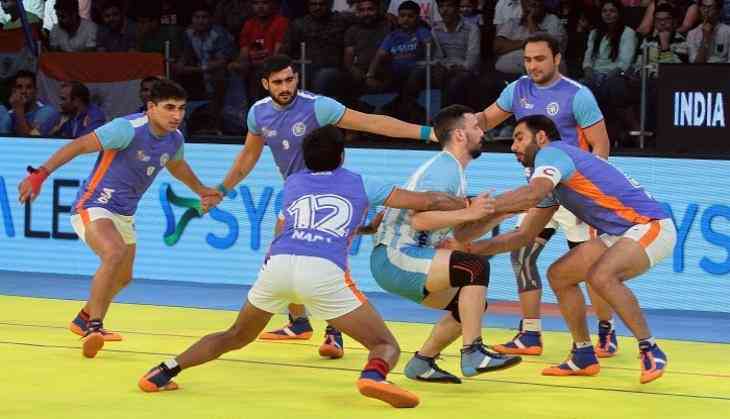The game of Kabbadi is one of the oldest games of. (Traditional style), Beach Kabaddi (Beach style) and Circle Kabaddi ( Circle style).

Kabaddi Kabaddi is one of the popular game among the peoples of Asia, especially in the villigers of India,Pakistan,Bangladesh,Sri Lanka,Nepal and Japan.Some people think that it is an Indian game but the reality is that no one really knows about the origin of this game. Some historian believe that it is about 4,000 year old game. This game involve skills and powers of two teams and combines the characteristics of wrestling and rugby.
It was originally meant to develop self defence, in addition to responses to attack, and reflexes of counter attack by individuals, and by groups or teams. It is a rather simple and inexpensive game, and neither requires a massive playing area, nor any expensive equipment. This explains the popularity of the game in rural areas.
Kabaddi is played all over Asia with minor variations. Kabaddi is also known by various names viz. Chedugudu or Hu-Tu-Tu in southern parts of India, Hadudu (Men) and Chu - Kit-Kit (women) in eastern India, and Kabaddi in northern India. The Game In Kabaddi, two teams compete with each other for higher scores, by touching or capturing the players of the opponent team. Each team consists of 12 players, of which seven are on court at a time, and five in reserve. The two teams fight for higher scores, alternating defence and offense.
The court is as large as that for a dodge ball game. The game consists of two 20 minute halves, with a break of five minutes for change of sides. The kabaddi playing area is 12.50m x 10m, divided by a line into two halves.
The side winning the toss sends a 'raider', who enters the opponents' court chanting, 'kabaddi-kabaddi'. The raider's aim is to touch any or all players on the opposing side, and return to his court in one breath. The person, whom the raider touches, will then be out. The aim of the opposing team, will be to hold the raider, and stop him from returning to his own court, until he takes another breath. If the raider cannot return to his court in the same breath while chanting 'kabaddi', he will be declared out. Each team alternates in sending a player into the opponents' court. If a player goes out of the boundary line during the course of the play, or if any part of his body touches the ground outside the boundary, he will be out, except during a struggle.
Lona The team scores a lona ( a bonus of two points), if the entire opposition is declared out. The game then continues by putting all the players on both sides. Matches are staged on the basis of age-groups, and weight. Seven officials supervise a match - one referee, two umpires, two linesmen, a time keeper and a scorer. Shin koihime musou otome ryouran sangokushi engi games free. Types of Kabaddi In India, Kabaddi is recognised in three forms: Surjeevani Gaminee Amar The 'Surjeevani' form of Kabaddi is played under the Kabaddi Federation of India, and is governed by its rules and regulations. In the 'Surjeevani' form of Kabaddi, one player is revived against one player of the opposite team who is out. One out, one in.
Archive
- Huawei E173 Celcom Firmware Vs Software
- Joint Operations Typhoon Rising Wiki
- Alpha Centauri Resolution Hack
- Applemacsoft Drm Converter Keygen Generator Golf
- Best Word List For Fern Wifi Cracker For Mac
- Benz Ir Nec Key Programmer Software
- Qt Platform Plugin Windows 10
- Giga Nas Dongle Firmware Update
- Campeon Plus 8 18 Crack
- El Quijote Dela Mancha Editorial Zig Zag Pdf To Excel
- Dimsport Genius Software How To File
- Stalker Call Of Pripyat Gamedata Folder Icon Mac
- Safeassign Plagiarism Software Reviews
- Hidden And Dangerous 2 Sabre Squadron Keygen Serial
- Bose Firmware Update Ae2w Manual